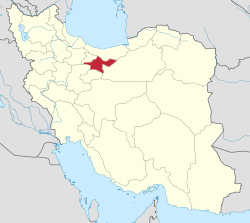Golestan District (Baharestan County)
 From Wikipedia - Reading time: 8 min
From Wikipedia - Reading time: 8 min
Golestan District
Persian: بخش گلستان | |
|---|---|
| Coordinates: 35°30′22″N 51°10′03″E / 35.50611°N 51.16750°E[1] | |
| Country | Iran |
| Province | Tehran |
| County | Baharestan |
| Capital | Golestan |
| Population (2016)[2] | |
• Total | 306,726 |
| Time zone | UTC+3:30 (IRST) |
Golestan District (Persian: بخش گلستان) is in Baharestan County, Tehran province, Iran.[3] Its capital is the city of Golestan.[4]
History
[edit]After the 2006 National Census, the district (except the city of Nasirshahr) was separated from Robat Karim County in the establishment of Baharestan County, which was divided into two districts of two rural districts each, with the cities of Golestan and Nasimshahr as its capitals.[3]
Demographics
[edit]Population
[edit]At the time of the 2006 census, the district's population (as a part of Robat Karim County) was 317,731 in 78,298 households.[5] The following census in 2011 counted 325,077 people in 89,904 households.[6] The 2016 census measured the population of the district as 306,726 inhabitants in 89,837 households.[2] As of 2024, the population is 232,004.[7]
Administrative divisions
[edit]| Administrative Divisions | 2006[5] | 2011[6] | 2016[2] |
|---|---|---|---|
| Meymanat RD | 7,107 | 8,258 | 7,353 |
| Salehabad RD | 722 | 983 | 1,134 |
| Golestan (city) | 231,882 | 259,480 | 239,556 |
| Nasirshahr (city)[b] | 23,802 | ||
| Salehieh (city)[c] | 54,218 | 56,356 | 58,683 |
| Total | 317,731 | 325,077 | 306,726 |
| RD = Rural District | |||
See also
[edit]Notes
[edit]References
[edit]- ^ OpenStreetMap contributors (18 September 2024). "Golestan District (Baharestan County)" (Map). OpenStreetMap (in Persian). Retrieved 18 September 2024.
- ^ a b c Census of the Islamic Republic of Iran, 1395 (2016): Tehran Province. amar.org.ir (Report) (in Persian). The Statistical Center of Iran. Archived from the original (Excel) on 12 December 2021. Retrieved 19 December 2022.
- ^ a b c Rahimi, Mohammad Reza (21 December 2013) [Approval 21 December 1389]. Approval letter regarding national divisions in Tehran province. rc.majlis.com (Report) (in Persian). Ministry of the Interior, Council of Ministers. Notification 293643/T44783H. Archived from the original on 5 March 2016. Retrieved 23 October 2023 – via Islamic Parliament Research Center.
- ^ a b Habibi, Hassan (c. 2013) [Approved 15 July 1375]. Reforms of national divisions in Tehran province. rc.majlis.ir (Report) (in Persian). Ministry of the Interior, Political-Defense Commission of the Government Board. Notification 101667/T16980K. Archived from the original on 30 May 2013. Retrieved 25 December 2023 – via Research Center of the System of Laws of the Islamic Council of Farabi Mobile Library of Mobile Users.
- ^ a b Census of the Islamic Republic of Iran, 1385 (2006): Tehran Province. amar.org.ir (Report) (in Persian). The Statistical Center of Iran. Archived from the original (Excel) on 20 September 2011. Retrieved 25 September 2022.
- ^ a b Census of the Islamic Republic of Iran, 1390 (2011): Tehran Province. irandataportal.syr.edu (Report) (in Persian). The Statistical Center of Iran. Archived from the original (Excel) on 20 January 2023. Retrieved 19 December 2022 – via Iran Data Portal, Syracuse University.
- ^ "Golestan Population 2024 - Population Stat". Chislennost.com. Retrieved 14 February 2024.
- ^ Rahimi, Mohammad Reza (c. 2022) [Approved 22 September 1391]. Approval letter regarding the name change of Salehabad city in Tehran province. rc.majlis.ir (Report) (in Persian). Ministry of the Interior, Political and Defense Commission. Notification 217517/T48385K. Archived from the original on 23 June 2022. Retrieved 26 December 2023 – via Islamic Council Research Center.
 KSF
KSF
